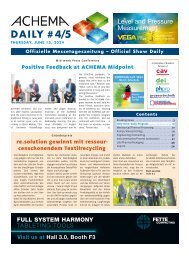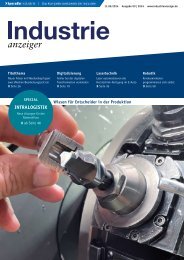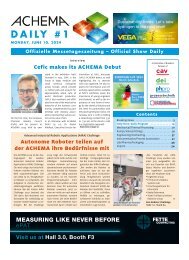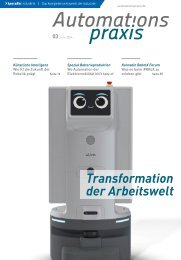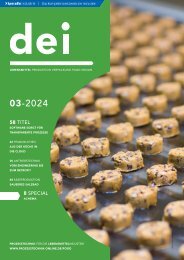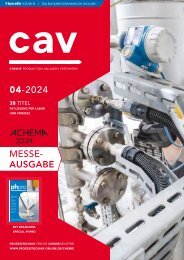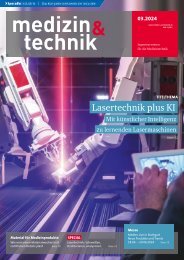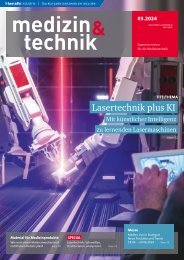EPP Europe P2.2023
Create successful ePaper yourself
Turn your PDF publications into a flip-book with our unique Google optimized e-Paper software.
changes in inspection technologies have been hardware<br />
related,” Tuerk explains. “The next paradigm<br />
shift will be in the area of software. And artificial intelligence<br />
will be the driver.”<br />
Saving costs and personnel<br />
In addition to machinery acquisition and maintenance<br />
costs, personnel costs have the biggest impact<br />
on the price of inspection processes. In addition to<br />
personnel to classify abnormalities at the verification<br />
station, experts are required for the creation of inspection<br />
programmes. In this area, AI can reduce<br />
human effort and save money. A clear trend for customisation<br />
is evident among electronics manufacturers<br />
across the world – small batch sizes need to be<br />
produced and inspected quickly and, of course, costeffectively.<br />
In this case, an inspection programme<br />
that works from the first assembly can be created in<br />
just a few clicks using various assistance functions.<br />
Thanks to artificial intelligence, this will be achievable<br />
without the intervention of an employee in the<br />
future - contributing significantly to a reduction in<br />
inspection costs for very small batches.<br />
The future of programme creation<br />
Artificial intelligence has been used in Goepel inspection<br />
systems for several years. The time employees<br />
require to conduct various processes is already<br />
being reduced. Step by step, beginning with<br />
the semi-automation of processes, we are moving<br />
towards the final goal – fully automated,<br />
autonomous inspection.<br />
In the past, inspection programmes began with<br />
data import. Article numbers were manually assigned<br />
to existing library entries. Finally, the test parameters<br />
were manually adjusted. All of this was time-consuming.<br />
Nowadays, this process looks a little different<br />
- although automated programme creation still<br />
starts with data import. Component parameters<br />
Christina Schellbach,<br />
Public Relations<br />
Manager at Goepel<br />
electronic<br />
(name, position, article number, and so on), layout<br />
and pad information are now readily available but<br />
detailed information about the housing and the<br />
solder joint (dimensions, height, pin shape) is still<br />
missing. To obtain this, the 3D AOI system creates an<br />
exact image of the respective housing and solder<br />
joints using the first produced assembly. This information<br />
is then used to determine the respective<br />
enclosure shape and to assign all required test functions.<br />
The test programme is created and a component<br />
library is automatically generated based on article<br />
numbers. In the final stage, the test programme<br />
is executed and the test parameters are automatically<br />
adapted to the real process variations. To avoid<br />
slippage, tolerance limits are placed tightly around<br />
the actual measured values and corrected according<br />
to real fluctuations, taking plausibility criteria into<br />
account. This is called knowledge-based intelligence.<br />
In the future, it will be possible to create a test programme<br />
without the real image of the first assembly.<br />
A completely digital image of the PCB with components<br />
and solder joints – a digital twin – will be used<br />
in the creation of a new test programme without the<br />
need for an actual physical assembly.<br />
“There are already AI inspection functions that do<br />
not require any setting parameters because they use<br />
a pre-trained AI model for classification,” explains<br />
Tuerk. Examples of this include the x-ray inspection<br />
Andreas Tuerk,<br />
Product Manager<br />
for X-ray systems at<br />
Goepel electronic<br />
Source: Tina Dietrich/Göpel electronic<br />
AI advisor reduces<br />
workload for verification<br />
station staff;<br />
AI also protects<br />
against human error<br />
<strong>EPP</strong> <strong>Europe</strong> » 11 | 2023 53



